but first,
their starting-point ......
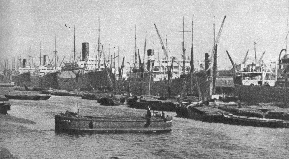
The
crowded Pool of London docks in the mid-1930's
with just some of the hundreds of Thames
lighters that served the arriving and
departing merchantmen (click photo to
enlarge)
Source -
"Shipping Wonders of the World", edited by
Clarence Winchester, mid-1930s
....
they were unpowered (but) could be, and were
moved with the tide using long sweeps or oars.
The ex-Zulu, now LBV.37 even made it across to
Normandy in this way after engine failure ...
and with a canvas tarpaulin as a sail
Only
one barge heading for Utah was lost in the
rough seas ...... what were "London river
barges (doing) crossing the English Channel
in that weather?"
|
1. THAMES BARGES TAKEN UP FOR
WAR
Requisitioning - In
April 1942, with America in the war and the Russians in
desperate straits, Winston Churchill was pressed to agree
to a small landing and holding operation in France around
Brest or Cherbourg in late 1942 (operation
"Sledgehammer"), followed by a main landing (operation
"Round-up" in 1943, later "Overlord" in 1944). That same
month, Lord Louis Mountbatten was appointed Chief of
Combined Operations, and apart from continuing with the
raids on Bruneval (radar station), St Nazaire (potential
"Tirpitz" dry-dock), and Dieppe (reconnaissance in force),
started planning for the European invasions. With so few
purpose-built landing craft available for what would be a
largely-British operation, one of his first tasks was to
requisition 1000 ‘dumb’ (unpowered) Thames lighters. They
were to be fitted with stern ramps, towed to the French
coast by minesweepers and beached using tugs and launches.
Many were later engined and armed. "Slegehammer" and
"Round-up" were soon cancelled, but by the time of the
Normandy landings in June 1944, 400 barges were to take
part manned by 3,500 men. Making up only ten percent of
total amphibious vessels, their role was nevertheless of
major importance. Apart from providing fuel, water,
prepared food, repairs and maintenance to the many
hundreds of landing craft serving both the American and
British beaches, their specialised cargo-carrying and
beach-landing characteristics meant they moved immense
quantities of supplies from ship-to-shore.
Trials and Early
Exercises - The first trials of a Thames lighter
fitted with a ramp had been held earlier in October 1941,
and included landing exercises with three trucks.
Following Lord Mountbatten’s appointment and starting in
April 1942, 1000 barges were towed by trawlers and tugs in
around 50 convoys to south coast of England ports for
conversion in Operation "Consular". This movement was
completed by September 1942 without loss. The first
exercises were held at Salcombe, Devon in September 1942
with five converted barges. The first major supply
exercise involving barges (36 in 3 flotillas), 36 coasters
and other forces, took place at Tenby, South Wales in
July/August 1943 in Exercise "Jantzen". As part of the
preparation for sailing across the English Channel for the
Normandy landings, "Jantzen" meant "dumb" Thames River
barges sailing from the south coast of England
around Land’s End and across the
Bristol Channel under their own power. They subsequently
made even longer coastal voyages.
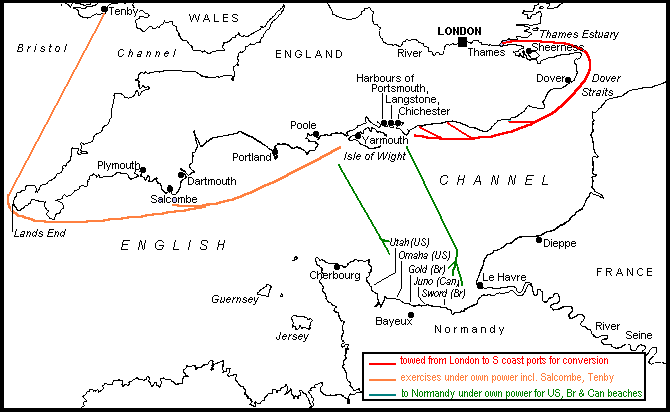
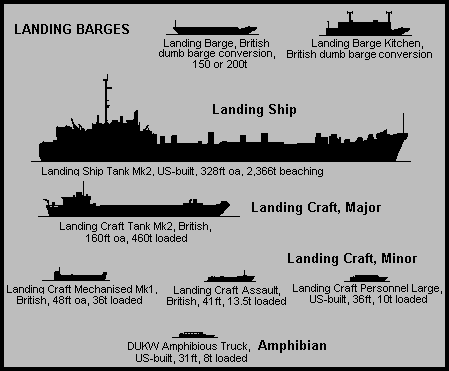 Development
of
Landing Barges - The very first requisitioned but
unconverted dumb barges (LB - landing barges) were simply
towed. The next stage was the addition of a ramp for
loading and unloading vehicles - LBR or Landing Barge,
Ramped. Adding engines (and later a rudder) to the ramped
barges led to the LBV or Landing Barge Vehicle. Development
of
Landing Barges - The very first requisitioned but
unconverted dumb barges (LB - landing barges) were simply
towed. The next stage was the addition of a ramp for
loading and unloading vehicles - LBR or Landing Barge,
Ramped. Adding engines (and later a rudder) to the ramped
barges led to the LBV or Landing Barge Vehicle.
The Main Types -
LBV’s were mainly used to carry vehicles and supplies from
ship-to-shore, especially equipment that was too big or
bulky or heavy for DUKWs. The second major use of the
converted Thames lighters was to provide the specialist
vessels needed to form Supply & Repair (S&R)
flotillas, and included Landing Barges Oiler (LBO), Water
(LBW), Kitchen (LBK) and Emergency Repair (LBE). The
third, but more restricted use was as Landing Barges Flak
(LBF) and Gun (LBG). There was also one Landing Barge
Cable (LBC).
right - Landing barges and
how they slotted in between the major and minor landing
craft in size and often function
Drawing - Gordon Smith
2001
2. THE BARGES AND THE CONVERSIONS
Barges or lighters were used
in large numbers to load and unload ships in harbour. With
so much of Britain’s shipping diverted to west coast
ports, by 1942 many of the River Thames’ barges were
laying idle. Some 1000 were therefore commandeered from
the total of approximately 3000 owned by the lighterage
companies that served London’s docks. They were all
individually named, and the first two requisitioned were
"Starter" (later LBV.63) and "Nucocus" (LBV.2). Others
included "Heritage" (LBE.47), "Hermit II" (LBE.49) and
"Zulu" (LBV.37). Made of steel, and carrying loads between
150 and 200 tons, they were designed to take considerable
wear and tear, and also to sit on the bottom in tidal
water while heavily laden and without being damaged. They
were known as "swim dumb" barges: "swim" because of the
overhanging hull at bow or stern; "dumb", as they were
unpowered, either by sail or engine. Instead they had to
be towed, although they could be, and were moved with the
tide using long sweeps or oars. The ex-Zulu, now LBV.37
even made it across to Normandy in this way after engine
failure.
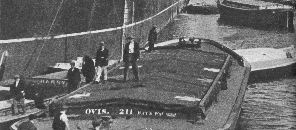 More
Thames
lighters in the London docks in the 1930's. Perhaps some of
the men shown here later served on them in the Royal Navy.
The broad beam gives an idea of just how much space they
provided for the various roles they played (click photo
to enlarge) More
Thames
lighters in the London docks in the 1930's. Perhaps some of
the men shown here later served on them in the Royal Navy.
The broad beam gives an idea of just how much space they
provided for the various roles they played (click photo
to enlarge)
Source - "Shipping Wonders
of the World", edited by Clarence Winchester, mid-1930s.
These lovely two old volumes contain a wealth of
photographs, maps and drawings now mainly lost to sight
Early Royal
Navy-requisitioned barges were fitted with ramps and some
internal concrete reinforcement, but still towed to their
destination. The first conversions used letters AA, BB,
CC, CCR, MBB, MCC followed by numbers. Twin engines were
then fitted but without rudders. Later, wheelhouse boxes
and rudders were installed.
Some of the barges were
converted by London shipyards, but over a thousand by
yards along the south coast of England. In addition to the
Navy’s barges, others were taken up by the Inland Water
Transport Division of the British Army’s Royal Engineers.
Initially fitted with Ford and Thornycroft car engines,
most if not all were re-engined with US lease-lend
Chrysler marine engines. The barges designed to carry
vehicles - both LBV’s and LBE’s - had the stern "swims"
removed and replaced with a large ramp operated by a hand
winch, and removable watertight bulkheads. To beach, the
barges had to approach the shore stern-first, a difficult
and dangerous operation in anything other than calm
weather.
A squadron of barges
supporting a beachhead comprised a number of LBV and LB
(S&R) flotillas - the first type for transport, and
the second for repair and the supply of fuel, water and
food.
3. TYPES OF CONVERSIONS
All Types -
originally 100t, 150t, or 200t carrying capacity, up to
85ft long, 23ft beam, around 4.5ft draught. Fitted with
two Chrysler 130hp marine petrol engines, speed 5.5kts,
single rudder, usually on starboard side below wheelhouse.
Also around 900 gallons water, coal for cooking and
heating.
Numbering:
LB’s, LBR’s, LBV’s, both
Mark 1 & 2, were collectively numbered from 1-500
LBE's, LBF's, LBG's, LBK's,
LBO's and LBW's, each numbered from 1-up
DEFENCE &
TRANSPORTATION BARGES:
Landing Barge Flak,
LBF - two flotillas (25th, 26th
LBF) of 8 and 7 barges respectively, each barge had an
officer in command. Conversions designed to provide
beach defence, particularly the Mulberry Harbour at Gold
Beach, 2-40mm Bofors/2-20mm Oerlikons, 1+up to 10 crew,
1+ up to 20 army gunners, totalling up to 32 men.
Landing Barge Gun, LBG
- armed with two Army 25-pounders, they are referred to
in LC, but do not appear to have entered service, or at
least reached Normandy.
Landing Barge Vehicle,
LBV - 19 flotillas (1st-16th,
18th-20th LBV) each of 12 barges.
To transport a wide range of vehicles, weapons, stores
and ammunition from ships and coasters to the beachhead.
Examples include 2-6pdr guns/3 lorries or
2-3t/2-30cwt/1-15cwt lorries; fitted with ramp. Armed
with twin Lewis guns. Crew of 5 including PO or L/S
coxswain. LBV’s were medium or large, 150t or 200t
carrying capacity. According to the glossary in BS.39,
Mark 1’s were dumb i.e. no engines and towed, or Mark 2
with two, usually, Chrysler engines. However, WB
suggests that most of the so-called "dumb" Mark 1’s were
actually powered by the time of Normandy.
LANDING BARGE (SUPPLY
AND REPAIR) FLOTILLAS, LB (S&R) - 10 flotillas
(30th-39th) each of around 6 LBE’s,
10 LBO’s, 2 LBW’s, 1 LBK:
Landing Barge
Emergency, or Emergency Repair, of Engineering, LBE
- to provide maintenance and repair facilities for
landing craft, including salvage. Equipped with stern
ramp and carried workshop lorry (generator, lathe,
drills, forge, anvil etc) which could be landed when
needed or crawler crane for landing when possible. The
LBE also carried its own generator, benches, welding
& cutting equipment, forge & anvil, pumps, spare
batteries etc and displayed a REPAIRS sign. Carrying
capacity - 150t or 200t ; main armament, 20mm Oerlikon;
1+9 deck/engine-room/maintenance crew, plus flotilla
specialists up to total of 25. Each barge had officer in
command.
Landing Barge Oil, LBO
- to supply diesel or petrol to coastal forces, landing
craft, landing barges; refuelled from fuel tankers lying
offshore. Equipped with cylindrical 40t/9,000 gallon
capacity tank, two 5inch hand pumps, and displayed a
DIESEL, PETROL, 73 OCT (‘Pool’ petrol), 87 OCT or 100
OCT sign; not ramped. Carrying capacity - 150t or 200t;
armed with twin Lewis guns; crew of 5 including PO or
L/S coxswain. Unpopular posting as considered a floating
bomb and no smoking had to be observed at all times
(officially).
Landing Barge Water,
LBW - to supply water to coastal forces, landing
craft, landing barges; refuelled from water tankers
lying offshore. Equipped with cylindrical 40t/9,000
gallon capacity tank, two 5inch hand pumps, and
displayed a WATER sign; not ramped. Carrying capacity -
150t or 200t ; armed with twin Lewis guns; crew of 5
including PO or L/S coxswain
Landing Barge Kitchen,
LBK - to provide prepared food, mainly for small
landing craft. Large superstructure, equipped as galley
to supply fresh bread and food equal to 1,600 hot and
800 cold meals daily; carried provisions to feed 900 men
for one week. Not ramped, displayed a FOOD sign, 1+22
crew. Sometimes armed with a stripped Lewis gun. Each
barge had an officer in command - like most of the
others, a sub lieutenant or midshipman RNVR. They have
also been referred to as "Bakeries", probably because of
the smell of baking bread wafting across the water.
plus Landing Barge
Cable, LBC - to work with cable-laying ships
providing cable communications between UK and France; only
1 commissioned, no ramp, 1+5 crew plus additional
cable-laying crew. Equipped with diesel generator, carried
telephone cable in hold, no armament.
4. NORMANDY FLOTILLAS AND LANDING BARGE DISPOSITIONS
(all information from WB; variations with BS.39 are
noted)
The actual
course taken by the vast invasion fleet to the Normandy
beaches was into "The Spout" just SE of the Isle of
Wight, then south down one of ten swept channels to the
US, British and Canadian beaches
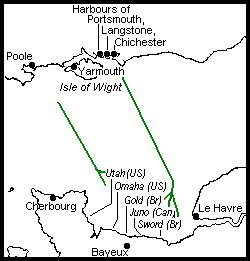
Abbreviations
used for sources of information
- see full list at end :
"British Vessels Lost at Sea, 1939-1945", (HMSO or H)
"Battle Summary No.39: Operation Neptune, (BS.39 or 39)
"Those Wallowing Beauties" (WB or wb)
"Warships of World War II, Part Eight: Landing Craft" (LC)
Additional material from Landing Barges Reunion (BR or br)
BRITISH
BEACHES
(LCE, Landing Craft Emergency Repair were
attached to S&R flotillas)
Gold
Beach
25th LBF Flotilla
from Chichester - LBF.1, 3, 6, 7, 12, 13, 14, 15 (bs.39
- 7 not 8 barges)
26th LBF Flotilla
from Chichester - LBF.2, 4, 5, 8, 9, 10 (flotilla
barge), 11
4th LBV Flotilla
from Langstone, half
for Gold, half for Juno beaches - taken from LBV.17, 36,
41, 58, 60, 91, 125, 139, 169, 183, 215, 224
13th LBV Flotilla
from Yarmouth, Isle of Wight - LBV.110, 133, 143, 152,
159, 165, 166, 189, 196, 197, 198, 236 (bs.39 - 8 not 12
barges)
14th LBV Flotilla
from Chichester or Yarmouth - LBV.144, 162, 163, 164,
179, 185, 188, 194, 213, 217, 222, 227 (bs.39 - 9 not 12
barges). In September 1944, 14th and 15th flotillas were
taken over by the Army’s RASC
15th LBV Flotilla
from Chichester/Yarmouth - LBV. 138, 142, 148, 167, 177,
178, 190, 204, 205, 208, 216, 240. In September 1944,
14th and 15th flotillas were taken over by the Army’s
RASC
36th LB (S&R)
Flotilla from Chichester - LBE.18, 23, 38 (11?),
49 (flotilla barge), 50, 51; LBO.9, 14, 17, 23, 39, 53,
55, 73, 75, 80; LBW.10, 17; LBK.4; LCE.23; four attached
fuelling trawlers (bs.39 - 1 not 2 LBW).
38th LB (S&R)
Flotilla from Yarmouth, Isle of Wight- LBE.3, 5,
13, 14, 24, 48 (flotilla barge); LBO.3, 19, 22, 60, 70,
71, 72, 76, 81, 86; LBW.11, 19; LBK.1; LCE.24; three
attached fuelling trawlers.
Juno
Beach
All flotillas sailed from Langstone Harbour
1st LBV Flotilla -
LBV.19, 20, 28, 34, 45, 90, 97, 116, 123, 126, 128, 130
(bs.39 - 11 not 12 barges)
2nd LBV Flotilla -
LBV.4, 18, 22, 38, 40, 46, 57, 71, 86, 115, 127, 235
(bs.39 - 11 not 12 barges)
3rd LBV Flotilla -
LBV.6, 25, 47, 48, 52, 54, 74, 107, 120, 122, 223, 231
4th LBV Flotilla,
half for Gold, half for
Juno beaches - taken from LBV.17, 36, 41, 58, 60, 91,
125, 139, 169, 183, 215, 224
30th LB (S&R)
Flotilla, part to Juno beach (3 LBE, 4 LBO, 2
LBW), rest to Sword (3 LBE, 6 LBO, 2 LBW, 1 LBK) taken
from LBE.2, 4, 16, 36, 43, 47; LBO.32, 33, 34, 38, 40,
41, 45, 48, 64, 90; LBW.5, 14 plus two?*; LBK.10;
LCE.15; four fuelling trawlers (*bs.39 totals 4 not 2
LBW).
31st LB (S&R)
Flotilla - LBE.6, 9, 21, 22, 39, 54; LBO.4, 7, 8,
20, 28, 43, 47, 49, 66, 83; LBW.2, 9; LBK.9; LCE.16; 4
fuelling trawlers
37th LB (S&R)
Flotilla - LBE.15 (flotilla barge), 19, 20, 44,
45, 56; LBO.1, 2, 29, 35, 36, 58, 59, 61, 67, 78; LBW.3,
16; LBK.2; LCE.19; three fuelling trawlers
Sword
Beach
All flotillas sailed from Langstone Harbour
5th LBV Flotilla -
LBV.10, 13, 24, 32, 59, 75, 77, 85, 96, 108, 114, 238
6th LBV Flotilla -
LBV.1, 43, 44, 88, 99, 111, 117, 119, 135, 199, 200, 201
16th LBV Flotilla
- LBV.145, 146, 147, 155, 171, 173, 180, 193, 195, 202,
221, 237
35th LB (S&R)
Flotilla - LBE.1, 7, 35, 40, 42, 53; LBO.5, 12,
15, 25, 31, 42, 50, 51, 52, 85; LBW.12, 13; LBK.6;
LCE.13; 3 refuelling trawlers
30th LB (S&R)
Flotilla, part to Sword (3 LBE, 6 LBO, 2 LBW, 1
LBK), rest to Juno beach (3 LBE, 4 LBO, 2 LBW) taken
from LBE.2, 4, 16, 36, 43, 47; LBO.32, 33, 34, 38, 40,
41, 45, 48, 64, 90; LBW.5, 14 plus two*; LBK.10; LCE.15;
four fuelling trawlers (*bs.39 totals 4 not 2 LBW).
AMERICAN
BEACHES
Utah
Beach
All flotillas were British-manned, and sailed from
Poole
8th LBV Flotilla -
LBV.5, 9, 14, 15, 16, 21, 30, 51, 65, 73, 82, 83
19th LBV Flotilla
- LBV 29, 31, 35, 50, 63, 72, 87, 113, 118, 121, 137,
174 (bs.39 - 11 not 12 barges)
20th LBV Flotilla
- LBV 151, 154, 157, 170, 175, 181, 184, 186, 187, 210,
212, 230 (bs.39 - 8 not 12 barges)
33rd LB (S&R)
Flotilla - LBE.12, 30, 32; LBO 13, 21, 24, 26, 77,
79, 82, 92, 95, 96; LBW 6; 1 fuelling trawler (bs.39 - 2
not 3 LBE)
34th LB (S&R)
Flotilla - LBE.28, 33, 34, 37, 52, 55; LBO 6, 11,
30, 44, 54, 63, 69, 87, 88, 89; LBW 1, 4; LBK 3, 8; four
fuelling trawlers
Omaha
Beach
All flotillas were British-manned, and sailed from
Poole
7th LBV Flotilla -
LBV 3, 11, 23, 53, 67, 70, 76, 101, 153, 206, 214, 225
9th LBV Flotilla -
LBV 98, 100, 132, 140, 141, 156, 161, 172, 176, 211,
228, 239
10th LBV Flotilla
- LBV 2, 26, 49, 68, 78, 79, 81, 103, 105, 131, 150, 192
11th LBV Flotilla
- LBV 8, 27, 61, 69, 84, 89, 95, 104, 106, 124, 191, 232
12th LBV Flotilla
- LBV 12, 33, 42, 64, 66, 92, 94, 109, 160, 203, 209,
229
18th LBV Flotilla
- LBV 7, 37, 39, 55, 62, 80, 93, 102, 129, 136, 149, 168
32nd LB (S&R)
Flotilla - LBE 26, 31, 57, 58, 59, 60; LBO 10, 16,
18, 37, 46, 56, 57, 84, 97; LBW 7, 8; LBK 5; 4 fuelling
trawlers
39th LB (S&R)
Flotilla - LBE 8, 10, 17, 25, 27, 29, 41, 46; LBO
27, 68, 93, 98; LBW 15, 18, 20; LBK 7; nine fuelling
trawlers
|